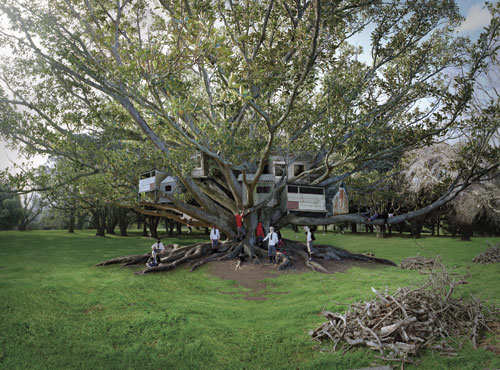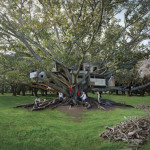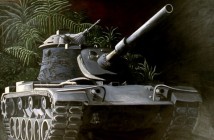BADLANDS @ MASS MOCA
The title of the current landscape show at Mass MoCA, Badlands: New Horizons in Landscape, refers to the geographical place in the Dakotas, “an area filled with both inhospitable conditions and immense beauty,” while simultaneously suggesting a landscape that is in “bad shape,” according to curator Denise Markonish. The legacy of the Hudson Valley Painters, characterized by their idealized vision of a pure landscape, seems to haunt the whole of the exhibit. The historical impulse to unveil beauty from the landscape becomes mixed with the need to represent environmental peril. Consequently, much of the work presented straddles the line between repulsive and beautiful representations of landscape.
Alexis Rockman’s long, horizontal painting, South, inspired by a recent trip to Antarctica, references the tradition of the sublime in both scale and subject matter. However, Rockman’s image seems to be melting in an alchemy, where thickly modeled icebergs digress into drips of paint and the sky spreads out as an aqueous, chemical spill. The overall effect is one of spectacular environmental atrophy. Similarly, Lelia Daw suggests a sense of nature falling apart. In her mixed-media piece, Volcano to the Sea, Daw places a volcano at the top of a severe vertical format. In a carefully considered formal language that references quilts and incorporates a range of contrasting materials (metallics, cloth, sand, ink etc.), she depicts a landscape with lava pouring down the picture plane, suggesting slippage and deterioration.
Much of the other work in the show has a similar sense of lament. However, this lament easily veers in the direction of environmental politics. It’s at this juncture that the show becomes most edgy. J. Henry Fair’s series of large-scale photographs picturing pollution sites in the United States sits squarely within this political, and possibly moralistic, inquiry. Fair’s aerial photographs of difficult-to-visit waste sites expose the cost of consumption and corporate irresponsibility. In Outlet, Fair photographs a phosphor-gypsum fertilizer waste center in Louisiana. Upon initial view the photograph appears as a striking abstract composition in white and blue. However, upon closer inspection the viewer realizes that the white ground is solid gypsum containing heavy metals, from which juts a pipe feeding a brilliant pool of aqua liquid. Clearly, this is art meant to teach you something– a sharp departure from the modernists, such as Diebenkorn and Mondrian, that he references in his abstract compositions. This moralistic theme within the show is perhaps the most novel element in the exhibit, suggesting a move from the sentiment that art should not instruct, an idea that many artists have held since the creation of Monet’s empirically based landscape paintings.
Along with this mild preachiness comes the threat of oversimplification. With titles like Forest Fire, New Valdez and Pond Scum, painter Melissa Brown offers a more generic view of environmental disaster as compared to J. Henry Fair. In Forest Fire, Brown paints a seductive picture of burning trees under a toxic-red sky. A Budweiser blimp lurks above the trees, while small animals curiously poke their heads out of the brush. The picture is devoid of naturalism and borrows freely from cartoons, graphic art, and traditional and contemporary Asian traditions. The flat-footed language seems to underscore the obvious point: nature is in peril, the animals are sad, consumerism (humans) are responsible. However, the longer I stayed with the piece, the more fraught the message became. Why is this serious topic communicated in such a playful aesthetic? I concluded that Brown is interested in exposing the distanced, fantastical way in which we perceive of environmental disasters. Her reality is one informed by dramatic news accounts, not first-hand observation. This reality echoes throughout the show as it becomes apparent that many of these artists are not observers of nature; rather they are urbanities probably listening about environmental issues on NPR.
The photographs of Robert Adams, along with the plein-air paintings of Mike Glier, stand in firm contrast to this distanced view of nature. Robert Adams creates sincere black-and-white photographs of peripheral images: shrubs, mailboxes, non-descript streets, a polluted ravine, drainage ditches etc. A number of these photographs are from his series Listening to the River and aptly reveal a sensitive facility that carefully listens to nature. Adams gained prominence in the 1970s with the New Topographics, a group of photographers interested in countering Romanticized views in American landscape photography. Consequently, Adams’ work is decidedly anti-spectacular. Nonetheless, a sense of the Romantic lingers within his vanishing roads, setting suns, and open fields. His photographs place the legacy of the Romantic and the spoiled American landscape in a melancholic embrace. It’s this complexity, along with his heartfelt observation of an abused land, which makes his work compelling without feeling overly emphatic or contrived.
The quieter note of Adams’ work reverberated in a few other pieces, including Mary Temple’s Northeast Corner, Southwest Light, an ethereal wall and floor painting of shadows emanating from a window. However, this type of work was pushed to the outskirts of the exhibit, drowned out by the louder, clamoring pieces. This uneven volume, along with an uneven mix of media, was the show’s greatest weakness. Nonetheless, perhaps this disunity serves to reflect a contemporary experience of nature: one that is inherently ambivalent - marked by sadness, serenity, beauty, and repulsion.
- Anthony Goicolea, Tree Dwellers, 2004
"Badlands: New Horizons in Landscape" is on view May 24, 2008 - April 9, 2009 at Mass MoCA.
All images are courtesy of Mass MoCA.





